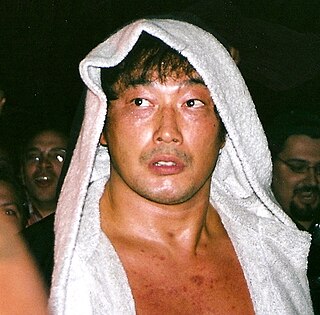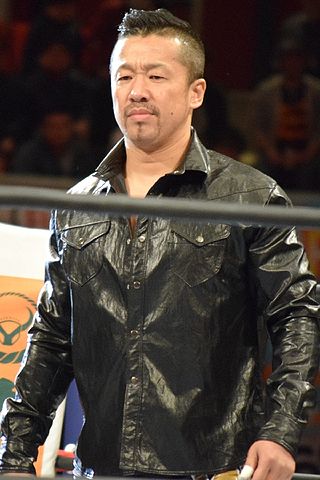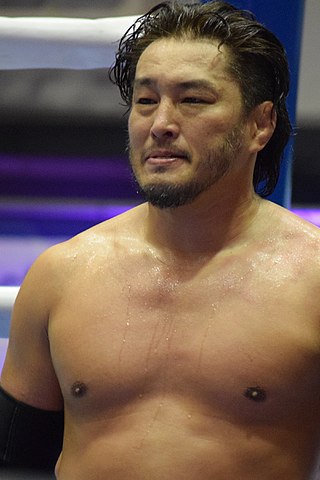
All Japan Pro Wrestling (AJPW/AJP) or simply All Japan is a Japanese professional wrestling promotion established on October 21, 1972, when Giant Baba split away from the Japanese Wrestling Association and created his own promotion. Many wrestlers had left with Baba, with many more joining the following year when JWA folded. From the mid-1970s, All Japan was firmly established as the largest promotion in Japan. As the 1990s began, aging stars gave way to a younger generation including Mitsuharu Misawa, "Dr. Death" Steve Williams, Kenta Kobashi, Gary Albright, Toshiaki Kawada, Mike Barton, Akira Taue and Jun Akiyama, leading to perhaps AJPW's most profitable period in the 1990s.

Mitsuharu Misawa was a Japanese professional wrestler and promoter. He is primarily known for his 18-year stint with All Japan Pro Wrestling (AJPW), and for forming Pro Wrestling Noah in 2000. In the early 1990s, Misawa gained fame alongside Toshiaki Kawada, Kenta Kobashi, and Akira Taue, who came to be nicknamed AJPW's "Four Pillars of Heaven", and whose matches developed the ōdō style of puroresu and received significant critical acclaim. Despite never working in the United States during the 1990s, Misawa had a significant stylistic influence upon independent wrestling, through the popularity of his work among tape-traders worldwide including the United States, the United Kingdom, Canada, and Australia.

Pro Wrestling Noah is a Japanese professional wrestling promotion, founded in 2000 by former All Japan Pro Wrestling (AJPW) wrestler Mitsuharu Misawa after he had led a mass exodus in which 24 of AJPW's 26 contracted wrestlers left the promotion to form Noah.

Kenta Kobashi is a Japanese professional wrestling promoter and retired wrestler. Broadly referred to by the nickname "Tetsujin", he is widely regarded as one of the greatest professional wrestlers of all time. He is best known for his two runs in All Japan Pro Wrestling (AJPW) and Pro Wrestling Noah (NOAH), of which he captured AJPW's Triple Crown Heavyweight Championship thrice, and NOAH's GHC Heavyweight Championship once. He is the winner of numerous Match of the Year and Wrestler of the Year awards, including from the Wrestling Observer Newsletter (WON) and Tokyo Sports.

Jun Akiyama is a Japanese professional wrestler signed to DDT Pro-Wrestling, where he is a former KO-D Openweight Champion. He is best known for his time working for All Japan Pro Wrestling (AJPW), where he was the president, representative director, co-head booker, and an in-ring performer. In AJPW, he is a former two-time Triple Crown Heavyweight Champion, while also being a six-time overall professional wrestling world champion.
Akira Taue is a Japanese retired professional wrestler. He is also a former All Japan Pro Wrestling Triple Crown Heavyweight Champion, a former GHC Heavyweight Champion and has had fifteen 5 Star Matches as awarded by the Wrestling Observer Newsletter.

Yoshihiro Takayama is a Japanese former professional wrestler and mixed martial artist. Debuting for UWF International (UWFI) in the 1990s, Takayama joined All Japan Pro Wrestling (AJPW) in 1997 after UWF-i folded. In 2000, he joined Pro Wrestling Noah (Noah), and later became a mainstay in New Japan Pro-Wrestling (NJPW) where he arguably achieved his greatest success, holding the IWGP Heavyweight Championship and NWF Heavyweight Championship simultaneously in 2003. He is one of only five men to hold all three puroresu major heavyweight titles, the others being Kensuke Sasaki, Keiji Muto, Satoshi Kojima, and Yuji Nagata.

Yasuhiro Suzuki, better known by the ring name Kotaro Suzuki, is a Japanese professional wrestler currently signed to Gleat. He is best known for working for the Pro Wrestling Noah and All Japan Pro Wrestling promotions, where he was a four-time GHC Junior Heavyweight Champion for Noah and a one-time World Junior Heavyweight Champion for AJPW.
Akitoshi Saito is a Japanese retired professional wrestler primarily known for his tenures with Pro Wrestling Noah (Noah) where he is a former five-time GHC Tag Team Champion and a former two-time Global Tag League winner in 2008 and 2011. Saito is also known for a seven-year stint with New Japan Pro Wrestling (NJPW).

Naomichi Marufuji is a Japanese professional wrestler signed to Pro Wrestling Noah. Marufuji is a four-time GHC Heavyweight Champion, as well as the first of two men to win Junior Heavyweight Championships in all three major Japanese promotions. In 2009, he was appointed to the position of Vice President of Pro Wrestling Noah, and has retained the position since, being reappointed in September 2011. He also makes occasional appearances in other professional wrestling promotions including New Japan Pro-Wrestling (NJPW), All Japan Pro Wrestling (AJPW), Ring of Honor (ROH), and Impact Wrestling.

Yoshinobu Kanemaru is a Japanese professional wrestler, signed to New Japan Pro-Wrestling, where he is a member of Bullet Club, and its sub-group House of Torture. He also works as a backstage producer. Kanemaru was a member of the Suzuki-gun stable from 2016 till the stable disbanded in 2022. Kanemaru joined the Just 5 Guys stable with former Suzuki-gun members before defecting to join House of Torture. Kanemaru is best known for his work in Pro Wrestling Noah, where he holds the record for the most reigns with the GHC Junior Heavyweight Championship.

Takashi Sugiura is a Japanese professional wrestler, currently working for Pro Wrestling Noah (Noah). Sugiura, an accomplished amateur wrestler, joined Noah's dojo in 2000, making his professional debut on December 23, 2000, and thus becoming the first wrestler to make his pro wrestling debut in Noah. He has also competed in mixed martial arts with a notable victory over Giant Silva. Sugiura wrestled as a junior heavyweight in his earlier pro career and is a former GHC Junior Heavyweight Champion. Sugiura moved up to heavyweight and became the second longest reigning GHC Heavyweight Champion, having held the title for 581 days between December 2009 and July 2011. As of September 2011, Sugiura is the chairman of Noah's Wrestler's Association and holds the concomitant position on the promotion's board of directors.

Takeshi Morishima is a Japanese former professional wrestler.

Shuhei Taniguchi is a Japanese professional wrestler who has worked for Pro Wrestling Noah since his debut in December 2005. He is also known by the ring name Maybach Taniguchi, under which he portrays a villainous masked character.

Go Shiozaki is a Japanese professional wrestler currently signed to Pro Wrestling Noah. He is a record-holding five time former GHC Heavyweight Champion. He made his debut for the Pro Wrestling Noah in July 2004 and initially remained with Pro Wrestling Noah until the end of 2012 when he jumped to All Japan Pro Wrestling (AJPW). In AJPW, he became a one-time Triple Crown Heavyweight Champion and a two-time World Tag Team Champion, before resigning from the promotion in September 2015. Afterwards, he returned to Noah, where, in May 2016, he won the GHC Heavyweight Championship for the third time. He has also worked for American promotions Ring of Honor (ROH) and Full Impact Pro (FIP), winning the latter's World Heavyweight Championship. In August 2016, Shiozaki was appointed the chairman of Noah's wrestlers' association.
Richard Aslinger is a retired American professional wrestler, known by his ring name Richard Slinger. Slinger was a long-time mainstay of All Japan Pro Wrestling and later Pro Wrestling Noah, where he was one of two gaijin heels to compete in the promotion. He is also one of several Noah wrestlers to be featured in the Japanese video game King of Colosseum II.

Atsushi Aoki was a Japanese professional wrestler who worked for All Japan Pro Wrestling (AJPW) as a wrestler, president of talent relations and head trainer at their dojo.

Burning is a multi-promotional professional wrestling stable originally formed in All Japan Pro Wrestling (AJPW) in August 1998.

All Together is a series of professional wrestling events organized by United Japan Pro-Wrestling. Initially the All Together event series was organized by Japan's three biggest promotions; All Japan Pro Wrestling (AJPW), New Japan Pro-Wrestling (NJPW) and Pro Wrestling Noah (NOAH), in response to the March 2011 Tōhoku earthquake and tsunami. The first event was held in Tokyo on August 27, 2011, and the second in Sendai on February 19, 2012. All proceeds from the events were donated to Japanese Red Cross. The events featured no storylines or championship matches, instead they were booked as "supercards", putting together combinations of wrestlers from the three promotions that fans would normally not see. A third event called All Together: Again took place in Tokyo on June 9, 2023, as a memorial to NJPW founder Antonio Inoki who had died the previous year. A fourth event took place in Tokyo on May 5, 2024, in response to the 2024 Noto earthquake and was also the first event under the United Japan Pro-Wrestling (UJPW) banner, which comprises NJPW, DDT Pro Wrestling (DDT), Dragongate (DG), Big Japan Pro-Wrestling (BJW), NOAH and World Wonder Ring Stardom (STARDOM).
This is a list of Japanese professional wrestler Mitsuharu Misawa's championships and accomplishments. Misawa (1962–2009) debuted for All Japan Pro Wrestling (AJPW) in 1981, and began work as the second incarnation of the Tiger Mask gimmick in 1984. He achieved some success as the character, but when he unmasked mid-match in May 1990, Misawa was pushed to the top of the company, and became one of AJPW's most decorated wrestlers of the 1990s. When he led a mass exodus to start his promotion Pro Wrestling Noah, he continued to have great success until his death in an in-ring accident. Misawa also received significant critical acclaim from domestic and international publications throughout his career.




















